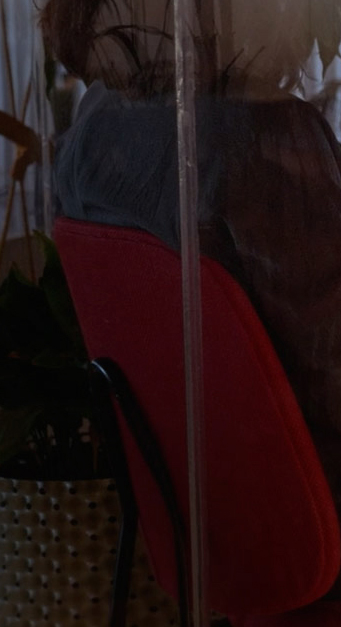
LESSONS IN LOVE I: ON REVOLUTIONARY FLIRTING
Word Count: 4,095 |
Download this article
by •
009: TENDER
with THE STROKER (PT II)
a video by PILVI TAKALA
Read this essay in French — Read this essay in Russian — Read this essay in Spanish
Abstract: What’s wrong with flirting? Why does online dating suck? Luce deLire answers: it’s capitalism. What can we do? We can develop counter-paradigms of seduction. Drawing on a trip to the Pink Totaliterian Re-education Camp (PTRD), deLire exemplifies this strategy in a model of receptive flirting, seven hands-on flirt exercises, and her own take on de-commodified love.
A response to Lessons in Love I will appear in April 2022 in Issue 010, written by Comrade Josephine.
“Whoever is new to flirting must flirt. There is no other way. Rehearse rehearse rehearse. Flirting is not cool. But better to fuck up than to die lonely.” (anonymous)
For the longest time, I was confused about the nature of heterosexual flirtation. Each time a heterosexual man would flirt with me, all I could hear was a resounding: “DICK?!” But I had no idea what that was supposed to mean or how to respond. Once, a man walked up to me while I was writing at a bar in Berlin, around 3 a.m. He said: “If you keep staring at this screen, you’ll soon need glasses.” I turned to him and responded: “And then I’ll look like you—or what?!” A middle-aged white European wearing glasses himself, he was very much taken aback and trailed off. Another time, my then partner and I were approached by a male teenager who expressed his fantasy of a threesome with two women by whistling: “Wow, I would love to get in between you right now!” To which I responded: “Yeah. And then you can suck my dick.” He was utterly confused and stopped pestering us. Yet in both cases, I had simply taken their advances literally and responded accordingly. But apparently that was not what they were looking for. What then is hetero-patriarchal flirting about?
Moments of first interaction often articulate a promise, an offer regarding what a social relation could look like. How will we relate? How will we care for each other? These men offered me oppression. They proclaimed: DICK! PHALLUS! POWER! OBEY! This toxic paradigm of erotics as obedience is here especially pronounced, embodied by straight men. Yet this pattern often occurs in less radical degrees and in non-cishet bodies as well, for example, when people insist on taking care of you by re-structuring your life, by reprimanding you for spending too much money, or not enough time at the gym, or by constantly making sure that your clothes fit correctly, your makeup is accurate, and all you say is nothing but the truth, and it accords to this or that normative framework. In short: they offer to become an extension of your super ego. But these kinds of relations are not just characterized by the imposition and adherence to some (at times secret) standard. Underneath the psychological formation of the superego lives the material reality of the police officer. The police officer is the guardian of property. The ideology of property is such that the use of your property is reserved exclusively for you, while everybody else is excluded from its use. My bank account, my white leather heels, and my sex toys are mine in that I alone decide if, how, and when they are being used (including all the notable exceptions, of course). The police prevent illegitimate use of property (allegedly). Broadly speaking, there may be police officers of property and capital in the classical sense, but also of cultural capital, of social capital, of emotional, intellectual, and most importantly, libidinal capital. And where flirting happens under the eyes of a police officer, it becomes toxic: it may feel nice initially, but is ultimately restrictive. The relation spun out of such toxic flirtation will soon turn into a prison, guarded by the police officers already present in the very first move. If joy is an increase of the desire that constitute us, then the restrictive relationship, woven out of toxic flirtation and guarded by the libidinal police, is a place of utter sadness, and necessarily so.
The almost universal logic of the police as agent of the commodification of everyday life is most obvious in the neoliberal mode of seduction. Everybody knows that dating apps require the full scale commodification of the self. On any such app, we turn ourselves into products, increasing our market value as best we can while simultaneously trying to prevent being returned to the shelf (the app) because the product did not match the ad (the profile). What is less talked about is the kind of subject these apps interpellate: a subject that chooses and is being chosen, according to preferences and other criteria. It is in fact nothing but the homo economicus, the neoliberal subject as consumer, whose primary concern is to strike a good deal, to make a good cut. The point is that dating apps turn their users into subjects of this kind, because this is the kind of subjectivity required by their overall design. The apogee of neoliberal seduction is ghosting, online and offline: Insofar as potential partners are mere commodities, they are disposable, expendable goods. Salad, crypto, yourfuturelover567 – the difference becomes marginal. Really, the entitlement to spontaneously interrupt an ongoing conversation or social relation without warning is a genuine expression of the commodified self. In ghosting, individual agents enact their alleged right to enter and withdraw from any (social) contract, assign and revoke the license to use their time, attention and a bare minimum of care whenever, wherever, engendered (and sometimes required) by the design of neoliberal capitalism.
This interpellation as consumer subject enters the practice of “first dates” as well. More often than not (and exceptions prove the rule), dates are conducted like contractual negotiations. It is the online profile all over again, but this time as performance piece. People present their skills, their fears, their damages, stake off territories, a.k.a. “check each other out.” “It’s a good shoe, great quality, solid, the heel is a bit loose, but patience and trust will fix that, could use some polishing, but if it fits you, you should take it (“it” being me).” The contract is signed in sex. Flirting in the neoliberal model functions as the signifier to its real meaning: sex. It really is, in its hetero-patriarchal form, the paradigm of signification as insemination: We talk. We fuck. BABIES. That is why, under hetero-patriarchal conditions, the “correct” response to the “flirtatious” address “DICK?!” is: “BABIES!”
“Do you want a dick?”
“Yes I want babies!”
BOOM. Love.
“Love” in this scenario becomes an extension of negative freedom, a space within which shared interests are pursued with added mutual support. It’s an asset, not a relation. Of course, many things can function as BABIES—a dog, a home, a life together, endless consumption of MDMA in dark rooms. The sky is the limit, and in restricted domains of neoliberal culture the hetero-patriarchal model has been pink washed into homonormative counterparts. And yet, the logic of property, of signification as insemination, remains the same: yes, we want to have something particular together. We want to own something—and that is why we need to negotiate in date form whether we want to invest in each other. However, I am not saying that apps don’t work. They can get you laid, coupled up, or even married. Maybe they don’t work better or worse than non-app dating, who knows. But the point is that they work because they respond to and function within a larger social framework: the total commodification of everyday life. And wherever that is not the case, it will be perceived as a refreshing exception to the overwhelming paradigm of seduction as contractual negotiation.
Is there another way? Yes.
Many people think that we need new narratives or new strategies to oppose the seemingly overwhelming power of neoliberal capitalism. I disagree. The new is too slow for the job. The new will only enter the marketplace of ideas, practices, and revolutionary proposals as yet another commodity with no other “radical potential” than to produce profit for some of its shareholders. But most importantly, the message most likely to arrive is the one that has been there all along. For all signification, all intelligibility is based on repetition. You always only see things in relation to what you have seen before, you always only understand things within previously established frameworks. And likewise, each action must be formed from whatever has existed before, each thing is created from the materials at hand. Thus, there is no novelty, no change, no revolution without repetition. In fact, repetition is the only way forward. For whereas we constantly repeat, we always repeat in another situation, another context, another set up, which is why the repetition will look just a little bit different, its effects will be just a little off. And that is how progress happens: repetition with a difference. Yet the question is: repetition of what? The point is thus not to come up with something “new” that may function as a disposable political project in the ever-hungry marketplace of ideas. Rather, the point is to repeat something that can unfold some gravitational pull against the given toxic paradigm of neoliberal seduction as contractual negotiation and policing. Thus, we need to access material affective resources that are already available. We need to find and kindle existing counter-paradigms, develop them, take care of them, let them grow, become enmeshed in them, popularize them, and thus change the material conditions that already exist. In what follows, I want to describe such a counter paradigm as I encountered it.
During my work with Comrade Josephine, the famed face of the revolutionary movement known as “Pink Totaliterianism,” I was lucky to visit a few sessions at a Pink Totaliterian Re-education Camp (PTRC). The camp functioned simultaneously as a corrective facility and an experimental site, a libidinal lab of sorts. The participants were mostly political activists, artists, burned-out managers, teenagers sent in by parents concerned about the social ineptness of their offspring, and meditation maniacs on the lookout for the next frontier. One exercise that people were encouraged to engage in was the extension of flirtatious behavior to situations traditionally thought of as non-erotic. This is one of the ways in which Pink Totaliterians try to redirect life from the accumulation of capital to the accumulation of pleasure. In so doing, they repeat an existing, though minor, social paradigm, transforming it into a full-blown alternative to life as we know it (or that’s the plan at least).
Pink Totaliterians understand “flirtation” to mean the form that seduction takes in direct interaction. They insist that flirting in particular, and seduction more generally, are not essentially connected to sex. And indeed, there is another mode of seduction, a genre of social connection in its own right, one that thrives on pleasure and the tantalizing, enticing play of various desires with one another. This is the kind of flirting that happens casually between strangers, at the dance floor, or within committed relationships. It’s you and me at a bar, or through a messaging app, etc. and may be articulated in a look, an off-hand joke, or a whole, late-night conversation. It is seduction for pleasure, seduction to please, not to bring about an extra-seductive goal. Yet any such possible goal may well be integrated in the process. Sex, drinks, and gifts may all occur within this kind of seduction. Yet they are not the envisioned ends. Rather, they are elements in the general process of seduction, and the more enthusiastic the consent, the more powerful sex, drinks, and gifts will become, and not the other way around.
Part of the process is to unlearn the understanding of one’s individuality, autonomy, independence, etc. as the articulation of some hidden inside of a singular being, divided from the world. Inversely, the pink individual is marked by receptivity, openness to an “outside” that is understood to be continuous with the self like in a Möbius strip. Receptivity is understood as a state beyond activity and passivity. The receptive seducer gets absorbed, loses herself in relationality, potentially returning to something that did not exist, or did not exist like that, before. Yet in receptive flirting, the detour, the non-arrival itself is exactly what arrives, what will have been “meant” to arrive. Receptive flirting is an enactment of repetition, with a difference, as described above, which Pink Totaliterians try to habituate as a revolutionary practice at an everyday micro level. In this sense, Pink Totaliterians understand flirting as a genuine transition: repetition begetting progress, where progress is not understood as approximation of a model but as a material process that pushes itself forward, constantly generating resources for more movement, more transition.
From the position of neoliberal flirting, receptive flirting can only be read as an infinite detour, inappropriate and at times encroaching, as it does not obey the boundaries between sexy times and non-sexy times, and neither does it envision a clear start nor end point. Yet that does not mean that my time at the PTRC would have been dominated by activist blokes bluntly creeping up on me, asking for initiation fucks. Quite the contrary. I felt an almost ultimate care and a genuine desire to make flirtation enjoyable for all participants, no matter how many were involved.
The two most important aspects of receptive flirting that I gathered from my visit at the PTRC are hospitality and permeability, which are basically the same thing in different respects. “Hospitality,” in this sense, means—tentatively—to account and make space for other people’s actions, needs, and expressions more generally. “Permeability,” however, is the ability—tentatively—to let yourself be transformed by the interaction with someone (or something) else. In matters of seduction, we need to be hospitable to one another—we need to allow for them to unfold, pick up on what they say and what they do, enter the game, and keep playing it. Instead of limiting the other, we want to provide a stage for them to shine. Simultaneously—and this is basically the same thing—we need to let ourselves become the other, pick up on their facial expressions, their puns, and mannerisms. What is hospitality toward the other is permeability towards ourselves. For the point here is not to insist on a solid identity for ourselves that is to be sold, but to wrap ourselves into one another and become something different, to envelop instead of developing. And in this sense, receptivity sidesteps signification as insemination, avoids marketability and does not submit to the logic of “DICK?!”—”BABIES!”
These are the lessons suggested to increase flirtatious receptivity at PTRC:
Lesson 0: Say “No.” In order to become a most graceful flirter, you may go through all the steps that follow (and whatever else you can come up with) with someone you are comfortable with and say “no” a few times at every step. It is important to know what a “no” feels like. Try to locate and savor the emotion that comes up with your training partner at every step on the way, try to determine when you would actually like to say “no.” Saying “no” is maybe the most crucial lesson of all. Only those who know how to say “no” can say “yes” with unflinching enthusiasm. And enthusiastic seduction is the most pleasurable for everybody involved.
Lesson 1: Eye Contact. Look into a person’s eyes just a little bit too long. You want them to notice, but you do not want them to feel stared at. When looking away, you may do so in a visible fashion. Let them know that you were looking at them, but don’t be intrusive. Wait for a response (verbally or otherwise). If the response is positive, look again—repetition substantiates the declaration of interest. Enthusiasm is power.
Lesson 2: Making the Move vs. Making them Make the Move. A central question is when to approach someone more directly. The easy answer is: always. But be gentle and prepare for rejection. If your attempt is not being reciprocated, don’t stick around to make things awkward or cause fear. However, approaching someone does not have to happen verbally. It can be a move (throw a kiss), a look, an object. Inversely, you can also make yourself approachable. You may, for example, move away from a group and sit down by yourself at a party, ask for a kind of help you know the person you are interested in can provide, in general: open the door so widely that it’ll be easy to walk through it. You can also use meta-language, such as “Is this the moment when we start talking to each other?” or “If we wanted to flirt, this would be a good time.”
Lesson 3: Minimize Authority. A central problem with toxic flirting is the underlying concept of authority: someone always determines what is real, who owns what, and what is supposed to happen. In order to turn flirting into a revolutionary practice, we need to grant space for ourselves and for others to flourish. We need to check in with each other without being anxious. We need to fight the police in our libidinal relations wherever we can.
Lesson 4: Overdetermination. Structurally, flirting is often ironic, meaning that two layers of meaning intersect, where one layer bears an intimate connotation. Sexualized jokes can be part of this. Other themes to explore include non-sexual intimacy, cuddling, protection, and safety. The graceful flirter allows for that intimate layer to expand without enforcing it. It is key to open that space gently so that other flirters involved can join in, but are also free not to engage with that second layer. If they do not engage, do not push it. If they do and the conversation becomes more intimate, do not hesitate to let down your guards.
Lesson 5: There Is No Truth to Flirting. It works like a theater improvisation—always say “yes.” And exaggerate. If they ask you if you are a bird, say yes and become a bird. Don’t resist, improvise. Be a character. Become someone else for the duration of the flirt. Remember: this is not a contractual negotiation. The flirt is your stage. Use it accordingly. If you have to leave, do so gracefully. If you decline talking about something, do it openly. Say: “I’m from the moon” or “My age? I’m a vampire. I stopped counting at 523. It got boring.”
Lesson 6: Endure Uncertainty. Because of the ironic structure of flirting, it may be unclear whether you are actually flirting or not. This is an enjoyable part of the game. You do not have to know where this is going. If it is going nowhere, that is perfectly fine. Just let the flirt unfold itself. This is where the pink flirt really differs from its neoliberal patriarchal counterpart: it is a fleeting force that permeates every relation with no strings attached, no set goal or end.
Lesson 7: Body Contact. There are two ways of initiating body contact: accidental and explicit. The latter is the easy one. You say: “Can I kiss you?” and if it’s a yes, you rejoice, if it’s a no, you stay put. Don’t think that this was taking any erotic quality out of the flirt. To the contrary: granting agency is hot. It is a genuine step in the process of seduction. The other, accidental way, is harder. It is a continuation of the ironic structure of flirtation. You may accidentally touch the other and see how they react, while leaving open the possibility that it was actually accidental. But be gentle! And never forget: the more enthusiastic the consent, the more powerful the seduction, and not the other way around.
Love is often considered an essential aspect of flirting per se. Yet love was not a part of the PTRC. Returning from the camp, I think pink love could be understood as fermented seduction. De-commodification might run through an integration of inevitable exclusion: instead of “I want to understand and share everything with you,” this other love says “I want to not be understood and excluded, disappointed and hurt by you. I could be hurt by many people, but it is this kind of damage that I prefer—your damage.” This other love would integrate the loss and the danger of emotional connection into its concept, hence admitting what commodified love can only mention: that loss, damage, and mistake are inevitable, not merely accidental. In this love, then, care would not be directed towards healing, but towards restaging the damage with the means of seduction. And seduction never ends—
Many thanks to: Anne Marie Wirth Cauchon, David Peterka
Curley, Edwin, editor and translator. The Collected Works of Spinoza, Volume I. Princeton, 1985, p.501 (E3p11s), p.531 (E3DA1-3).
deLire, Luce. “The Metaphysics of Desire–Aristotle, Avicenna, Cavendish, Spinoza and Beyond.” Libidinal Economies of Crisis Times, edited by Ben Gook, forthcoming, 2022.
Derrida, Jacques. Dissemination. Translated by Barbara Johnson, Athlon Press, 1981, p. 304.
THE STROKER

The Stroker is a two-channel video installation based on Takala’s two week-long intervention at Second Home, a trendy East London coworking space for young entrepreneurs and startups. During the intervention Takala posed as a wellness consultant named Nina Nieminen, the founder of cutting-edge company Personnel Touch who were allegedly employed by Second Home to provide touching services in the workplace. Nina strolled around Second Home being friendly to everyone, greeting and lightly touching people as she passed them by. It gets the office talking; workers gossip amongst themselves, visibly bonding over a common confusion—she was nicknamed “The Stroker.”
The responses of the “touchees” varied widely; most were polite, but there were those whose body language registered a visible discomfort. Perhaps simply due to the cultural context of this invasion of personal space, or perhaps as a result of the inner conflict that arises when one does not feel able to truthfully or openly react. When unable to assert oneself, this kind of embodied negotiation may take the place of words.
The nuances of movement demonstrate how people negotiate the dilemma of being mediated bodies under social pressure, and how such responses are controlled by the tacit conventions governing what is deemed to be “acceptable behaviour.” In the clear-walled, open-thinking space of The Stroker, we witness a physical negotiation of boundaries where there seemingly are none.
– Pilvi Takala
The Stroker is presented in two parts – find Part I alongside an essay by Jen Asturias elsewhere in Issue 009: TENDER here.
LUCE DELIRE writer
Luce deLire is a ship with eight sails and she lays off the quay. When night falls, she turns into a philosopher, performer, and media theorist. She loves visual art, installations, video art, etc. She could be seen curating, performing, directing, planning and publishing (on) various events. She is working on and with the philosophy of treason, infinity, atheism, and seduction—across disciplines and in mixed media.
PILVI TAKALA artist
Pilvi Takala is an artist living and working between Berlin and Helsinki. Her video works are based on performative interventions in which she researches specific communities in order to process social structures and question the normative rules of our behavior. Her works show that it is often possible to learn about the implicit rules of a social situation only by its disruption. Her work has been shown at MoMA PS1, New Museum, Palais de Tokyo, Kiasma, Kunsthalle Basel, Temple Bar Gallery + Studios, Manifesta 11, Careof, CCA Glasgow, International Film Festival Rotterdam, HotDocs, Witte de With, and the 9th Istanbul Biennial. Takala won the Dutch Prix de Rome in 2011, and the Emdash Award and Finnish State Prize for Visual Arts in 2013. Takala will represent Finland at the Venice Biennale, 2022.
THE STROKER (2018) 15:16 min two-channel video installation:
Director of Photography: Katharina Dießner
Sound Recording: Karl Laeufer, Luke David Harris
Editing: Elisa Purfürst
Sound Design: Christian Obermaier
Choreographer: Emma Waltraud Howes
Co-writer, Production Assistant: Iona Roisin
Production Assistant: Amelie Befeldt
Curator: Teresa Calonje Trenor
Title Design: Ana Fernandes
Performers: Donna Celay, Hais Hassan, Laura Hemming-Lowe, Manos Koutsis, Matthew Moorhouse, Patricia Mories, Iona Roisin, Emma Waltraud Howes
© Copyright for all texts published in Stillpoint Magazine are held by the authors thereof, and for all visual artworks by the visual artists thereof, effective from the year of publication. Stillpoint Magazine holds copyright to all additional images, branding, design and supplementary texts across stillpointmag.org as well as in additional social media profiles, digital platforms and print materials. All rights reserved.




